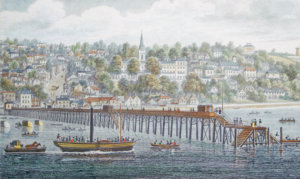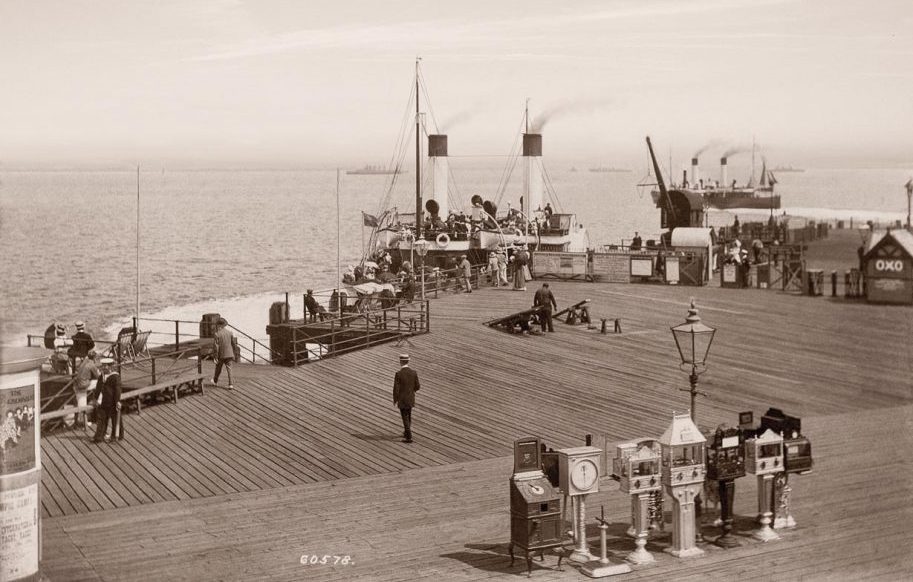 It is generally accepted as the oldest surviving pier in the country, and it also happens to be the second longest. Now plans are being drawn up for Ryde Pier to celebrate its 200th birthday in style.
It is generally accepted as the oldest surviving pier in the country, and it also happens to be the second longest. Now plans are being drawn up for Ryde Pier to celebrate its 200th birthday in style.
Although Ryde Pier, which stretches majestically out into the Solent some 681 metres, does not actually reach the 200-year milestone until July 26, 2014, it was in 1812 that an Act of Parliament was passed to allow its construction.
A year later the foundation stone was laid, and then in 1814 the residents of Ryde stood proudly and watched as the pier was finally opened to the public.
Wightlink Ferries now own the pier, and their marketing manager Kerry Jackson said: “We will be holding a ‘Party on the Pier’ in 2012 to celebrate the 200th anniversary of the Act of Parliament, and further celebrations will be taking place in 2013 and 2014 to mark the occasions.”
Since its opening the pier has survived wars and hurricanes. It has been extended, re-shaped and renovated. More importantly it has evolved as one of the main gateways to the Island, so we decided it was time to give readers an insight into its fascinating history.
Indeed, before the pier was built, passengers to Ryde had to leave their boats and come ashore on the back of a porter. Then, depending on the state of the tide, they had to walk up to half a mile across wet sand to reach shore.
The original pier structure was all timber, and measured 527 metres before being extended, to make it second to Southend as the longest pier. A second ‘tramway’ pier was built next to the first pier, opening in 1864, and allowing horse-drawn trams to take passengers from the pier head to the esplanade. Then in 1880 a third pier was opened, alongside the first two, providing a direct steam railway link to the pier-head.
 Island historian Adrian Searle explained: “The opening of Ryde Pier in 1814 was the defining event in the development of a town which hitherto had been effectively barred to the masses because of the difficulties of access. “Little more than two isolated hamlets in the 18th century, Ryde had been ‘discovered’ by the aristocracy in the years preceding the pier’s construction. The fine marine residences they built as summer retreats remain as faded, yet still elegant, reminders of the town’s fashionable origins. “But it was the building of the pier, sufficiently long to allow access at all states of the tide, which established Ryde as a ‘gateway’ to the Island for the wider population and paved the way for the town itself to develop as a desirable location for both residents and tourists. ”Ryde Pier was integral to the key subsequent phases of the town’s developing transport infrastructure. After the railway opened to Shanklin in 1864, a second pier, immediately east of the original promenade decking, was opened to allow a horse tramway to operate along its length and through the town to connect with the original station at Ryde (St John’s Road).
Island historian Adrian Searle explained: “The opening of Ryde Pier in 1814 was the defining event in the development of a town which hitherto had been effectively barred to the masses because of the difficulties of access. “Little more than two isolated hamlets in the 18th century, Ryde had been ‘discovered’ by the aristocracy in the years preceding the pier’s construction. The fine marine residences they built as summer retreats remain as faded, yet still elegant, reminders of the town’s fashionable origins. “But it was the building of the pier, sufficiently long to allow access at all states of the tide, which established Ryde as a ‘gateway’ to the Island for the wider population and paved the way for the town itself to develop as a desirable location for both residents and tourists. ”Ryde Pier was integral to the key subsequent phases of the town’s developing transport infrastructure. After the railway opened to Shanklin in 1864, a second pier, immediately east of the original promenade decking, was opened to allow a horse tramway to operate along its length and through the town to connect with the original station at Ryde (St John’s Road).
“Then, with the intervention of the big mainland rail companies, who brought hordes of passengers to their cross-Solent ferries at Portsmouth, the railway pier was added at Ryde in the 1880s as part of a major scheme to open up considerably enhanced ferry-train connections on the Island – ending the short life of the pier tramway’s town section in the process. ”Although the tramway pier, which survived the opening of the new railway, has not operated as such since 1969, overall Ryde Pier continues to perform a vital transport function – something which leaves it uniquely placed among the surviving seaside piers of England. Ryde built the nation’s most important pier. The pier built Ryde. The two are synonymous.” The pier continued to be a vital link between the mainland and the Island, and it was re-modelled using concrete in the 1930s, and by the mid 1950s the Ryde-Portsmouth service was in its heyday with queues on a Saturday regularly stretching the whole length of the pier and into Union Street.
The pier was made a Grade II listed building in 1976, and subsequently Wightlink catamarans run regularly between Ryde and Portsmouth, and it is possible to drive along the pier, with car parking on the large pier head.
 However, that was brought to a temporary halt from August 2010 to March 2011, when the pier was closed to all vehicles as structural work underneath the promenade pier failed to pass a regular inspection.
However, that was brought to a temporary halt from August 2010 to March 2011, when the pier was closed to all vehicles as structural work underneath the promenade pier failed to pass a regular inspection.
The pier did stay open to pedestrians, who used temporary decking on the tramway pier whilst much of the promenade pier was being renewed. After the £5million project was completed a toll charge of £1 for vehicles was introduced along with a height and weight restriction, and average speed cameras were also installed.
For a few decades Ryde also had the Victoria Pier, which stood a few hundred yards to the east of the original one. That pier opened in 1864 but as it was much shorter it could not be used in all tides. So in 1875 the ferry service ceased and Victoria Pier became a pleasure pier only, with public baths at the ‘wet end’ and a swimming platform at the ‘dry end’.
However, it fell into disrepair and because it was later considered a hazard its demolition was authorised by Act of Parliament during the First World War, and within a few years it had disappeared completely with not a single trace remaining.



